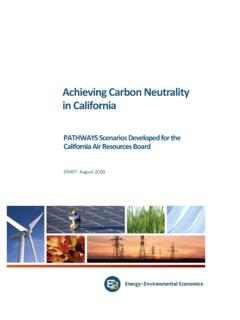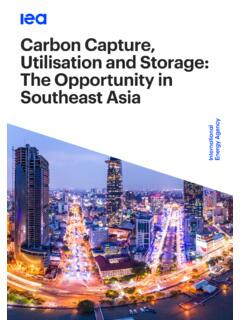Transcription of Methodology for GHG Emission Avoidance Calculation
1 Innovation Fund (InnovFund) Methodology for GHG Emission Avoidance Calculation Innovation Fund Small Scale Projects InnovFund-SSC-2020-single-stage Version 16 February 2021 EU Grants: Methodology for IF GHG Emission Avoidance Calculation : 2 HISTORY OF CHANGES Version Publication date Change Initial version. Updating the information on the EU ETS benchmarks to be used (those from 2011) (section 2); clarifications: reference Emission factor for renewable cooling (table ), calculations for GHG emissions generally excluded ( ), scope in section ; correction of clerical errors in formulas in and EU Grants: Methodology for IF GHG Emission Avoidance Calculation : 3 Methodology for Calculation of GHG Emission Avoidance Table of contents 1 Introduction .. 1 Calculation of GHG Emission Avoidance compared to reference scenario.
2 1 Specification of a sector for the purpose of the GHG Emission Avoidance calculations .. 2 GHG Emission Avoidance Calculation .. 3 Monitoring, reporting and verification of performance for disbursement and knowledge-sharing .. 5 2 Energy intensive industry (EII), including CCU, substitute products and biofuels .. 7 Scope .. 7 GHG Emission Avoidance .. 7 Absolute and relative GHG emissions Avoidance .. 21 Data and 21 Monitoring, reporting and verification of performance for disbursement and knowledge-sharing .. 22 Appendix Attribution of emissions to co-products in emissions calculations for IF projects .. 23 Appendix Processes with a fixed ratio of outputs: definition of rigid, elastic and semi-elastic products .. 24 Appendix Hierarchy of data sources for inputs and products in industrial projects .. 26 3 carbon capture and Storage .. 27 Scope.
3 27 Project boundary .. 28 Absolute GHG Emission Avoidance .. 29 Relative GHG Emission Avoidance .. 30 Data and 30 Monitoring, reporting and verification of performance for disbursement and knowledge-sharing .. 31 4 Renewable electricity, heat and cooling .. 33 Scope .. 33 Absolute GHG Emission Avoidance .. 35 Relative GHG Emission Avoidance .. 38 Data and 38 Monitoring, reporting and verification of performance for disbursement and knowledge-sharing .. 38 5 Energy storage .. 41 Scope .. 41 Project boundary .. 42 Absolute GHG Emission Avoidance .. 43 Relative GHG Emission Avoidance .. 45 Data and parameters .. 45 Monitoring, reporting and verification of performance for disbursement and knowledge-sharing .. 47 Appendix Classification of projects into sectors .. 50 Appendix Definitions .. 53 EU Grants: Methodology for IF GHG Emission Avoidance Calculation : 1 1 Introduction The Innovation Fund (IF) supports projects in energy intensive industries, carbon capture and utilisation (CCU), carbon capture and storage (CCS), energy storage and renewable energy.
4 The methodologies for the Calculation of the GHG Emission Avoidance are described in the following sections: 1) Energy intensive industries, including carbon capture and use, substitute products and biofuels 2) carbon capture and storage 3) Renewable energy, including manufacturing plants for components 4) Energy storage, including manufacturing plants for components Each section details the Methodology to be used when: 1) applying for an Innovation Fund grant; 2) reporting performance for the purposes of disbursement of 60% of the grant that is linked to GHG Emission Avoidance ; and 3) reporting performance for the purposes of knowledge-sharing1. Calculation of GHG Emission Avoidance compared to reference scenario The calculations of GHG Emission Avoidance should comprehensively cover the impacts from the changes in inputs, processes, and outputs between the project and the reference scenario.
5 The reference scenarios should reflect the current state-of-the-art in the different sectors, as shown in Table and Table Table Reference Scenarios Sector GHG emissions are based in the reference scenario (among others) on: Energy intensive industry EU ETS benchmark(s) or fossil fuel comparators (FFCs) in some cases or proposed by applicant if the reference cannot be constructed by combination of benchmarks and/or FFCs Energy intensive industry / Biofuels Adapted fossil fuel comparators from REDII CCS CO2 is not captured, but released/available in atmosphere Renewable electricity Expected 2030 electricity mix Renewable heat Natural gas boiler Renewable cooling Expected 2030 electricity mix Electricity storage Single-cycle natural gas turbine (peaking power) Electricity grid services Combined-cycle natural gas turbine (partial load) Heat / Hydrogen storage EU ETS benchmark for heat / hydrogen production Energy storage in vehicles Diesel-fuelled internal combustion engine 1 These parameters will be reported through a dedicated knowledge-sharing report template once projects enter into operation.
6 The detailed knowledge-sharing requirements are spelled out in the Model Grant Agreement, call text and knowledge-sharing reporting template. EU Grants: Methodology for IF GHG Emission Avoidance Calculation : 2 Table Emission factors for projects involving production, use and/or storage of grid electricity Sector Reference Scenario (Grid electricity substituted by net electricity export from the project / Discharging for energy storage) Project scenario (Net grid electricity consumed / Charging for energy storage) Energy intensive industry Expected 2050 electricity grid mix Expected 2050 electricity grid mix CCS [Not applicable] 2050 electricity grid mix Renewable electricity 2030 electricity grid mix 2050 electricity grid mix Renewable heat [Not applicable] Expected 2050 electricity grid mix Energy storage Single-cycle natural gas turbine (used for peaking power)
7 Expected 2050 electricity grid mix Specification of a sector for the purpose of the GHG Emission Avoidance calculations When submitting the application, the applicant needs to choose the sector under which the project falls (see Appendix for list of sectors). This choice will influence the points to be awarded for the first sub-criterion on the potential of absolute GHG Emission Avoidance (see call text for details). The application may only be submitted for one sector. However, applicants may combine activities related to two or more eligibility categories (energy-intensive industry, CCS, RES, energy storage) to be referred to as hybrid projects. In this case, applicants would need to choose a main sector, which correspond to the principal product(s) they intend to produce. The application can also concern two or more sectors in one category. In case that a project will earn revenues from the sale of a single product ( steel, solar electricity), it will be straightforward to choose the according sector.
8 Where a product will substitute another one of different composition (for example, ethanol to substitute gasoline in transport, rather than ethanol as a fine chemical), the relevant sector of the substituted product may be chosen (the refinery sector in this case). In the case that a project will earn revenues from the sale of several products, the applicant should define the principal product(s) . The principal product(s) should reflect the main aim and innovation of the project: is the project designed to principally save emissions in the steel industry, or to make alternative transport fuel (as a by-product of steelmaking)? The applicant will need to choose the sector to which the principal product(s) belong and claim the absolute GHG Emission Avoidance from the project in this sector. If multiple products are in the same sector ( a CCU process may produce gasoline, diesel, kerosene and fuel oil), the applicant can consider all or some of them as the principal products.
9 The applicant can also choose only one principal product . This choice of principal product(s) will influence the estimate of the project s relative GHG Emission Avoidance (see section ). The products that are not considered principal products should be listed under other products in Application Form Part B. EU Grants: Methodology for IF GHG Emission Avoidance Calculation : 3 Example A steelworks proposes a project to modify its existing plant to produce ethanol as well as steel products. The ethanol will be sold as an alternative transport fuel for blending in gasoline for road transport. The principal product could be chosen to be either steel or transport fuel. Either would be eligible for IF because they displace products made in the EU ETS, and because both the improvement of the carbon performance of the steel process and the production of ethanol are main aims of the project.
10 It is not possible to consider both the steel and ethanol principal products, however, as they are in different sectors (iron and steel vs refinery). As the project makes a relatively minor change to the steel emissions, relative emissions savings are likely to be higher if transport fuel is claimed to be the principal product. However, the applicant may consider that there is less competition for IF funds in the steel sector. Toluene is a minor by-product of the ethanol production. It could be added as a second principal product in the case that transport fuel is chosen as the principal product, as both are in the refinery sector. However, it would be artificial and disallowed to propose that toluene is the only principal product. Projects may aim also to sell the products in a market where they would displace a different product than the conventional use of the product, for example hydrogen that is used for heating rather than in a refinery.


















